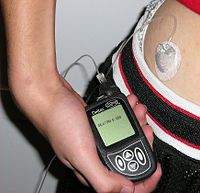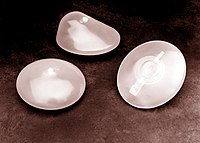Biomedical engineering: Difference between revisions
RCSIRCSIRCSI (talk | contribs) No edit summary |
m rv topic was discussed on talk page |
||
| Line 95: | Line 95: | ||
At the [[undergraduate]] level, an increasing number of programs are also becoming recognized by [[ABET]] as accredited bioengineering/biomedical engineering programs in the United States. [[Duke University]] was the first program accredited by the Engineering Council for Profession Development (now [[ABET]]) in September of 1972.<ref>[http://www.abet.org/schoolalleac.asp ABET List of Accredited Engineering Programs]</ref> |
At the [[undergraduate]] level, an increasing number of programs are also becoming recognized by [[ABET]] as accredited bioengineering/biomedical engineering programs in the United States. [[Duke University]] was the first program accredited by the Engineering Council for Profession Development (now [[ABET]]) in September of 1972.<ref>[http://www.abet.org/schoolalleac.asp ABET List of Accredited Engineering Programs]</ref> |
||
Currently, the [[US News and World Report]] ranks the [[Johns Hopkins University]] as having the best Biomedical Engineering program. |
|||
As with many degrees, the reputation and ranking of a program may factor into the desireability of a degree holder for either employment or graduate admission. The reputation of many undergraduate degrees are also linked to the institution's graduate or research programs, which have some tangible factors for rating, such as research funding and volume, publications and citations. |
As with many degrees, the reputation and ranking of a program may factor into the desireability of a degree holder for either employment or graduate admission. The reputation of many undergraduate degrees are also linked to the institution's graduate or research programs, which have some tangible factors for rating, such as research funding and volume, publications and citations. |
||
Revision as of 17:24, 23 March 2007











Biomedical engineering (BME) is the application of engineering principles and techniques to the medical field. It combines the design and problem solving expertise of engineering with the medical expertise of physicians to help improve patient health care and the quality of life of healthy individuals. As a relatively new discipline, much of the work in biomedical engineering consists of research and development, covering an array of fields: bioinformatics, medical imaging, image processing, physiological signal processing, biomechanics, biomaterials and bioengineering, systems analysis, 3-D modeling, etc. Examples of concrete applications of biomedical engineering are the development and manufacture of biocompatible prostheses, medical devices, diagnostic devices and imaging equipment such as MRIs and EEGs, and pharmaceutical drugs.
Disciplines within Biomedical Engineering
Biomedical engineering is widely considered an interdisciplinary field, resulting in a broad spectrum of disciplines that draw influence from various fields and sources. Due to the extreme diversity, it is not atypical for a biomedical engineer to focus on a particular aspect. There are many different taxonomic breakdowns of BME, one such listing defines the aspects of the field as such:[1]
- Bioelectrical and neural engineering
- Biomedical imaging and biomedical optics
- Biomaterials
- Biomechanics and biotransport
- Biomedical devices and instrumentation
- Molecular, cellular and tissue engineering
- Systems and integrative engineering
In other cases, disciplines within BME are broken down based on the closest association to another, more established engineering field, which typically include:
- Chemical engineering - often associated with biochemical, cellular, molecular and tissue engineering, biomaterials, and biotransport.
- Electrical engineering - often associated with bioelectrical and neural engineering, bioinstrumentation, biomedical imaging, and medical devices.
- Mechanical engineering - often associated with biomechanics, biotransport, medical devices, and modeling of biological systems.
- Optics and Optical engineering - biomedical optics, imaging and medical devices.
Clinical engineering
Clinical engineering is a branch of biomedical engineering for professionals responsible for the management of medical equipment in a hospital. The tasks of a clinical engineer are typically the acquisition and management of medical device inventory, supervising biomedical engineering technicians (BMETs), ensuring that safety and regulatory issues are taken into consideration and serving as a technological consultant for any issues in a hospital where medical devices are concerned. Clinical engineers work closely with the IT department and medical physicists.
A typical biomedical engineering department does the corrective and preventive maintenance on the medical devices used by the hospital, except for those covered by a warantee or maintenance agreement with an external company. All newly acquired equipment is also fully tested. That is, every line of software is executed, or every possible setting is exercised and verified. Most devices are intentionally simplified in some way to make the testing process less expensive, yet accurate. Many biomedical devices need to be sterilized. This creates a unique set of problems, since most sterilization techniques can cause damage to machinery and materials. Most medical devices are either inherently safe, or have added devices and systems so that they can sense their failure and shut down into an unusable, thus very safe state. A typical, basic requirement is that no single failure should cause the therapy to become unsafe at any point during its life-cycle. See safety engineering for a discussion of the procedures used to design safe systems.
Medical devices
A medical device is intended for use in:
- the diagnosis of disease or other conditions, or
- in the cure, mitigation, treatment, or prevention of disease,
- intended to affect the structure or any function of the body of man or other animals, and which does not achieve any of its primary intended purposes through chemical action and which is not dependent upon being metabolized for the achievement of any of its primary intended purposes.
Some examples include pacemakers, infusion pumps, the heart-lung machine, dialysis machines, artificial organs, implants, artificial limbs, corrective lenses, cochlear implants, ocular prosthetics, facial prosthetics, somato prosthetics, and dental implants.
Stereolithography is a practical example on how medical modeling can be used to create physical objects. Beyond modeling organs and the human body, emerging engineering techniques are also currently used in the research and development of new devices for innovative therapies, treatments, patient monitoring, and early diagnosis of complex diseases.
Medical devices can be regulated and classified (in the US) as shown below:
- Class I devices present minimal potential for harm to the user and are often simpler in design than Class II or Class III devices. Devices in this category include tongue depressors, bedpans, elastic bandages, examination gloves, and hand-held surgical instruments and other similar types of common equipment.
- Class II devices are subject to special controls in addition to the general controls of Class I devices. Special controls may include special labeling requirements, mandatory performance standards, and postmarket surveillance. Devices in this class are typically non-invasive and include x-ray machines, PACS, powered wheelchairs, infusion pumps, and surgical drapes.
- Class III devices require premarket approval, a scientific review to ensure the device's safety and effectiveness, in addition to the general controls of Class I. Examples include replacement heart valves, silicone gel-filled breast implants, implanted cerebellar stimulators, implantable pacemaker pulse generators and endosseous (intra-bone) implants.
Medical Imaging
Imaging technologies are often essential to medical diagnosis, and are typically the most complex equipment found in a hospital including:
- Fluoroscopy
- Magnetic resonance imaging (MRI)
- Nuclear Medicine
- Positron Emission Tomography (PET) PET scansPET-CT scans
- Projection Radiography such as X-rays and CT scans
- Tomography
- Ultrasound
- Electron Microscopy
Tissue engineering
One of the goals of tissue engineering is to create artificial organs for patients that need organ transplants. Biomedical engineers are currently researching methods of creating such organs. In one case bladders have been grown in lab and transplanted successfully into patients.[2] Bioartificial organs, which utilize both synthetic and biological components, are also a focus area in research, such as with hepatic assist devices that utilize liver cells within an artificial bioreactor construct.[3]
Regulatory issues
Regulatory issues are never far from the mind of a biomedical engineer. To satisfy safety regulations, most biomedical systems must have documentation to show that they were managed, designed, built, tested, delivered, and used according to a planned, approved process. This is thought to increase the quality and safety of diagnostics and therapies by reducing the likelihood that needed steps can be accidentally omitted again.
In the United States, biomedical engineers may operate under two different regulatory frameworks. Clinical devices and technologies are generally governed by the Food and Drug Administration (FDA) in a similar fashion to pharmaceuticals. Biomedical engineers may also develop devices and technologies for consumer use, such as physical therapy devices, which may be governed by the Consumer Product Safety Commission. See US FDA 510(k) documentation process for the US government registry of biomedical devices.
Other countries typically have their own mechanisms for regulation. In Europe, for example, the actual decision about whether a device is suitable is made by the prescribing doctor, and the regulations are to assure that the device operates as expected. Thus in Europe, the governments license certifying agencies, which are for-profit. Technical committees of leading engineers write recommendations which incorporate public comments and are adopted as regulations by the European Union. These recommendations vary by the type of device, and specify tests for safety and efficacy. Once a prototype has passed the tests at a certification lab, and that model is being constructed under the control of a certified quality system, the device is entitled to bear a CE mark, indicating that the device is believed to be safe and reliable when used as directed.
The different regulatory arrangements sometimes result in technologies being developed first for either the U.S. or in Europe depending on the more favorable form of regulation. Most safety-certification systems give equivalent results when applied diligently. Frequently, once one such system is satisfied, satisfying the other requires only paperwork.
Biomedical engineering training
Education
Biomedical engineers combine sound knowledge of engineering and biological science, and therefore tend to have a bachelors of science and advanced degrees from major universities, who are now improving their biomedical engineering curriculum because interest in the field is increasing. Many colleges of engineering now have a biomedical engineering program or department from the undergraduate to the doctoral level. Traditionally, biomedical engineering has been an interdisciplinary field to specialize in after completing an undergraduate degree in a more traditional discipline of engineering or science, the reason for this being the requirement for biomedical engineers to be equally knowledgable in engineering and the biological sciences. However, undergraduate programs of study combining these two fields of knowledge are becoming more widespread, including programs for a Bachelor of Science in Biomedical Engineering. As such, many students also pursue an undergraduate degree in biomedical engineering as a foundation for a continuing education in medical school. Though the number of biomedical engineers is currently low (as of 2004, under 10,000 in the U.S.), the number is expected to rise as modern medicine and technology improves.[4]
At the undergraduate level, an increasing number of programs are also becoming recognized by ABET as accredited bioengineering/biomedical engineering programs in the United States. Duke University was the first program accredited by the Engineering Council for Profession Development (now ABET) in September of 1972.[5]
As with many degrees, the reputation and ranking of a program may factor into the desireability of a degree holder for either employment or graduate admission. The reputation of many undergraduate degrees are also linked to the institution's graduate or research programs, which have some tangible factors for rating, such as research funding and volume, publications and citations.
Education in BME also varies greatly around the world. The U.S. has, by virtue of being a large country with fewer internal barriers, having an extensive biotechnology sector and dozens of major universities, has progressed a great deal in the development of BME education and training. Europe, which also has a large biotechnology sector and an impressive education system, has encountered trouble in creating uniform standards as the European community attempts to bring down some of the national barriers that exist. Recently, initiatives such as BIOMEDEA have sprung up to develop BME-related education and professional standards.[6] Other countries, such as Australia, are recognizing and moving to correct deficiencies in their BME education.[7] Also, as high technology endeavors are usually marks of developed nations, some areas of the world are prone to slower development in education, including in BME.
Professional certification
Engineers typically require a type of professional certification, such as satisfying certain education requirements and passing an examination to become a professional engineer. These certifications are usually nationally regulated and registered, but there are also cases where a self-governing body, such as the Canadian Association of Professional Engineers. In many cases, carrying the title of "Professional Engineer" is legally protected.
As BME is an emerging field, professional certifications are not as standard and uniform as they are for other engineering fields. For example, the Fundamentals of Engineering exam in the U.S. does not include a biomedical engineering section, though it does cover biology. Biomedical engineers often simply possess a university degree as their qualification. However, some countries do regulate biomedical engineers, such as Australia, however registration is typically recommended, but not always a requirement.[8]
Founding figures
- Y. C. Fung - professor emeritus at the University of California, San Diego, considered by many to be the founder of modern Biomechanics[9]
- Robert Langer - Institute Professor at MIT, runs the largest BME laboratory in the world, pioneer in drug delivery and tissue engineering[10]
- Otto Schmitt (deceased) - biophysicist with significant contributions to BME, working with biomimetics
- Ascher Shapiro (deceased) - Institute Professor at MIT, contributed to the development of the BME field, medical devices (e.g. intra-aortic balloons)
- John G. Webster - a pioneer in the field of instrumentation amplifiers for the recording of electrophysiological signals
- U. A. Whitaker (deceased) - provider of The Whitaker Foundation, which supported research and education in BME by providing over $700 million to various universities, helping to create 30 BME programs and helping finance the construction of 13 buildings[11]
See also
Notes
- ^ BMES Bulletin, Vol. 30, November 2006
- ^ Doctors grow organs from patients' own cells, CNN, April 3, 2006
- ^ Trial begins for first artificial liver device using human cells, University of Chicago, February 25, 1999
- ^ U.S. Bureau of Labor Statistics - Profile for Engineers
- ^ ABET List of Accredited Engineering Programs
- ^ BIOMEDEA
- ^ Biomedical Engineering Curriculum: A Comparison Between the USA, Europe and Australia
- ^ http://www.nerb.org.au/aop/nper_areas_biomedical.cfm
- ^ YC “Bert” Fung: The Father of Modern Biomechanics (pdf)
- ^ Colleagues honor Langer for 30 years of innovation, MIT News Office
- ^ The Whitaker Foundation
Further reading
- Bronzino, Joseph D. (2000). The Biomedical Engineering Handbook - Second Edition. CRC Press.
- Volume 1. ISBN 0-8493-0461-X.
- Volume 2. ISBN 0-8493-0462-8.
External links
Organizations
- American College of Clinical Engineering (ACCE)
- Association of Institutions concerned with Medical Engineering (UK)
- Biomed.org
- Biomedical Engineering Meetings Calendar
- Biomedical engineering at the NIH
- Biomedical Engineering website
- Danish Society for Biomedical Engineering
- EBME - Biomedical and Clinical Engineering
- Foundation supporting biomedical engineering research
- The Biomedical Engineering Network
- The Biomedical Engineering Society (US)
- The Canadian Medical and Biological Engineering Society
- The Clinical Engineering Society of Ontario (Canada)
- BioMedicalWatch
- Thai Biomedical Engineering Research Society(ThaiBME)
Job Finder
Career Advice
